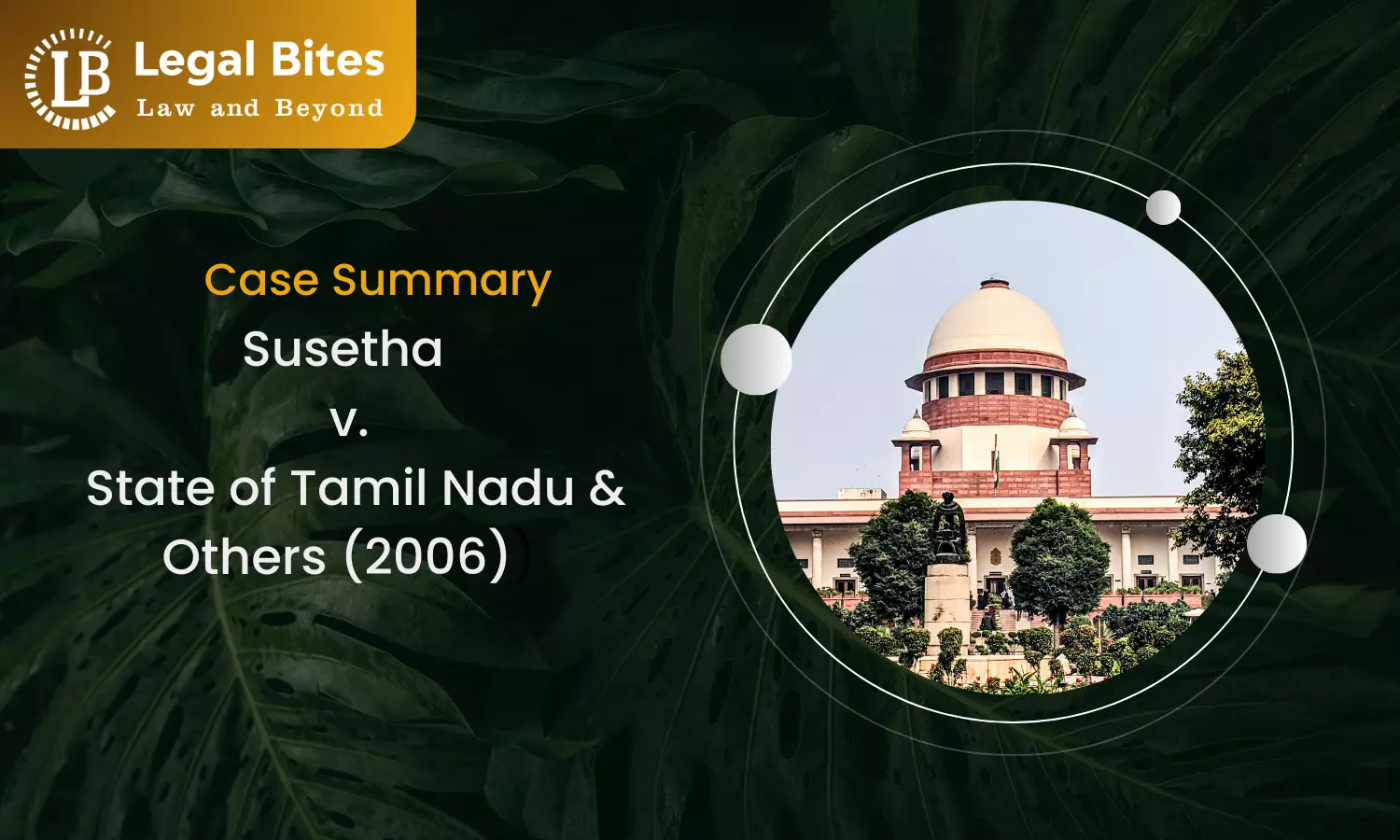Case Summary: Susetha v. State of Tamil Nadu and Others (2006) | Sustainable Development
The Supreme Court allowed the conversion of a disused temple tank into a shopping complex, balancing environmental concerns with resettlement needs.

The case reaffirms the judiciary’s commitment to sustainable development without sacrificing the rights enshrined under Article 21. While emphasizing the need for government accountability in public trust cases, the Court has clarified that preservation efforts may yield developmental goals, provided they do not endanger fundamental environmental stability.Case Title: Susetha v. State of Tamil Nadu and OthersCourt: Supreme Court of IndiaCitation: Appeal (Civil) 3418 of 2006Bench: Justice...
The case reaffirms the judiciary’s commitment to sustainable development without sacrificing the rights enshrined under Article 21. While emphasizing the need for government accountability in public trust cases, the Court has clarified that preservation efforts may yield developmental goals, provided they do not endanger fundamental environmental stability.
Case Title: Susetha v. State of Tamil Nadu and Others
Court: Supreme Court of India
Citation: Appeal (Civil) 3418 of 2006
Bench: Justice S.B. Sinha and Justice Dalveer Bhandari
Date of Judgment: 8th August 2006
Facts of the Case
The appellant, Susetha, claimed membership in the Okkiam Thoraipakkam Panchayat Union in Tamil Nadu, where a temple tank lay abandoned and in disuse. Situated near Chennai on Old Mahabalipuram Road, the tank was previously a water body classified as "tank poramboke" (reserved land for public utility). However, the Panchayat Union decided to repurpose the tank area to construct a shopping complex to resettle people displaced by a highway expansion project. The state of Tamil Nadu sanctioned this construction with an official government order.
The appellant challenged this decision in the Madras High Court, arguing that constructing a water body violated environmental obligations, especially given the water shortage in the region. The High Court, based on a report from the Director of the Centre for Water Resources at Anna University, dismissed the appellant’s petition. The report indicated that the tank had not been used as a water source for years, was unfit for human use, and had deteriorated to the point of functioning as a waste dump. Dissatisfied, the appellant sought relief in the Supreme Court, arguing for the conservation and rehabilitation of the tank.
Issues
- Whether the temple tank, an artificial water body, should be preserved as a water resource.
- Whether the State’s decision to repurpose the tank land for constructing a shopping complex violated environmental and public trust principles.
- The extent of the State’s obligation under Article 21 of the Constitution concerning environmental protection and water resource preservation.
Arguments by the Appellant
Arguments by the Respondents
Observations and Findings of the Court
Justice S.B. Sinha delivered the judgment, considering the environmental doctrines of public trust, sustainable development, and the State's role as a trustee of natural resources. The Court reiterated that:- Natural water resources are essential to protect for public use and environmental stability, as they contribute to groundwater recharge and the broader ecological balance.
- Artificial water bodies, unlike natural lakes or rivers, do not necessarily demand the same level of preservation unless they continue to serve a beneficial public purpose.
The Court analyzed the Centre for Water Resources report, highlighting the tank’s inadequate maintenance, lack of water purity, lack of inlet and outlet channels, and limited access. The tank’s condition and surrounding factors, such as its use as a waste dump and nearby alternative water tanks, led the Court to question the necessity of preserving this specific water body.
The Court acknowledged the significance of water preservation under Article 21, supporting citizens’ right to a healthy environment. Articles 47, 48-A, and 51-A of the Constitution further impose responsibilities on the State and citizens to protect natural resources.
However, the Court distinguished between natural and artificial tanks, clarifying that preservation efforts primarily apply to natural water bodies. In cases involving artificial tanks, pragmatic considerations, including public interest and developmental needs, may allow for repurposing.
Judgment
Legal Principles Established
- Public Trust Doctrine: This doctrine affirms that natural resources, especially water bodies, are held by the State in trust for public benefit. While the doctrine restricts the State’s rights to alienate these resources, it allows for limited repurposing if it meets a higher public interest.
Sustainable Development: As highlighted in Bombay Dyeing & Mfg. Co. Ltd. v. Bombay Environmental Action Group, sustainable development requires balancing environmental protection with societal needs. Development policies must consider environmental sustainability while addressing the needs of the current generation without compromising future generations.
Distinction Between Natural and Artificial Water Bodies: The Court emphasized that while natural water bodies warrant stringent protection, artificial tanks may be evaluated for repurposing based on their current condition and utility. In cases like this, involving an abandoned artificial tank used as a dumping ground, repurposing may be justified if it serves a significant public interest, such as the resettlement of displaced persons.
Judicial Scrutiny in Environmental Matters: The Court reiterated the need for rigorous judicial review when the government repurposes resources held in public trust. However, such scrutiny is pragmatic rather than absolute; development may proceed if it does not substantially undermine public environmental interests.
Analysis
In applying the public trust doctrine, the Court placed more emphasis on natural resources, signalling that artificial resources may be subject to pragmatic repurposing, particularly when maintenance costs outweigh their public benefit. This distinction could set a precedent for other cases involving abandoned or disused artificial water bodies. By affirming that artificial tanks do not require stringent protection if they serve a minimal ecological function, the Court allows flexibility for developmental initiatives in areas facing infrastructure challenges.
Conclusion
Click Here to Read the Official Judgment

Apurva Neel
I am a Research Associate and Editor at Legal Bites with an LL.M. specialization in Corporate and Commercial Laws from Amity University, Mumbai. I have put my best efforts into presenting socio-legal aspects of society through various seminars, conferences etc. I keep refining content as I am an ardent writer, and palpably law has got multi-dimensional aspect, so I passionately try to explore ahead.
